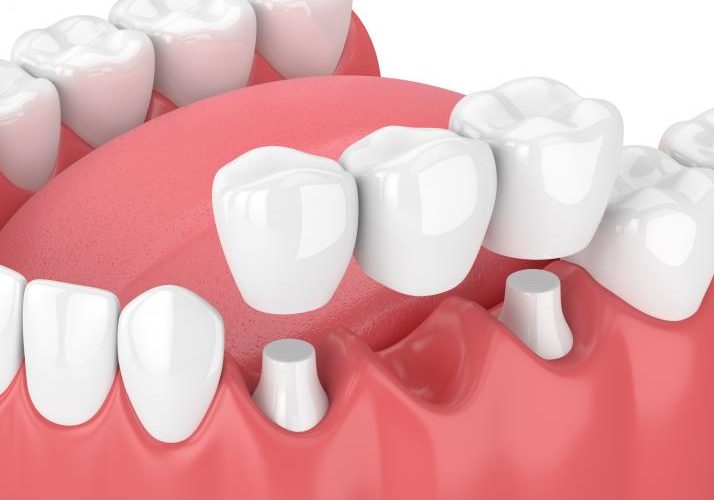Are you tired of hiding your smile because of unsightly gaps caused by missing teeth? It’s time to say goodbye to those gaps and hello to a perfect smile with porcelain bridges! These dental prosthetics are an excellent solution for restoring your teeth’ natural appearance, function, and alignment. In this blog post, we’ll explore the benefits of porcelain bridges and how they can help you achieve a beautiful, confident smile. So sit back, relax, and let’s dive into the world of dental bridges!
Porcelain Bridges
When you have a gap in your teeth, it can feel like the whole world is staring at you. You may feel self-conscious and find yourself avoiding social situations. But there’s no need to hide away porcelain bridges can help you achieve the perfect smile.
A porcelain bridge is an artificial tooth that is used to fill a gap in your teeth. The bridge is made up of two parts: the false tooth (or pontic) and the supporting wings (or abutments). The pontic is attached to the abutments, which are then bonded to your natural teeth.
Porcelain bridges are strong and durable, and they can last for many years with proper care. They are also very natural-looking, so no one will be able to tell that you have a fake tooth.
If you’re considering a porcelain bridge, talk to your dentist about whether it’s the right solution for you.
Benefits of Porcelain Bridges
Gaps in your teeth can cause a number of problems, both aesthetically and functionally. Porcelain bridges are a great way to close those gaps and achieve a beautiful, healthy smile. Here are just a few of the many benefits of porcelain bridges:
Aesthetics: Gaps in your teeth can be very noticeable and can detract from your overall appearance. Porcelain bridges can help improve the aesthetics of your smile by closing those gaps.
Functionality: Gaps in your teeth can also cause functional problems, such as difficulty chewing or speaking. Porcelain bridges can help improve the function of your teeth by filling in those gaps.
Health: Gaps in your teeth can trap food and bacteria, which can lead to cavities or other dental problems. Porcelain bridges can help improve the health of your teeth by preventing food and bacteria from getting trapped in the gaps.
Porcelain bridges are a great way to improve the aesthetics, function, and health of your teeth. If you have gaps in your teeth, talk to your dentist about whether porcelain bridges are right for you.
Types of Porcelain Bridges
There are many different types of porcelain bridges that a dentist can use to help close the gaps in your smile. The type of bridge that is best for you will depend on the number of teeth that need to be replaced, the location of the missing teeth, and the overall health of your mouth.
One common type of porcelain bridge is the cantilever bridge. This type of bridge is typically used when there are only one or two missing teeth. The cantilever bridge is supported by dental crowns that are placed on the healthy teeth next to the gap.
Another common type of porcelain bridge is the Maryland bridge. The Maryland bridge is usually used to replace front teeth that are missing. This type of bridge gets its name from the way it attaches to the supporting teeth. Metal wings are bonded to the back side of the supporting teeth and these wings help to hold the pontic (false tooth) in place.
The traditional fixed bridge is another option for closing gaps in your smile. This type of bridge consists of one or more points that are attached to dental crowns on either side.
No matter which type of porcelain bridge you and your dentist decide is best for you, you can rest assured knowing that this dental treatment can give you a beautiful and natural-looking smile!
The Procedure for Placing a Porcelain Bridge
If you’re missing one or more teeth, you may be considering a porcelain bridge. A porcelain bridge is a dental prosthetic that is used to fill in the gaps left by missing teeth. The procedure for placing a porcelain bridge is fairly simple and can be done in just a few visits to your dentist.
First, your dentist will take an impression of your teeth in order to create a custom-fit bridge for you. Next, they will place temporary bridges to help protect your gums and exposed teeth while your permanent bridge is being made. Once your permanent bridge is ready, your dentist will remove the temporaries and cement the new bridge into place.
With proper care, your porcelain bridge can last for many years to come. Be sure to brush and floss regularly and see your dentist for routine checkups and cleanings.
Possible Complications and How to Avoid Them
When it comes to dental bridges, one of the main concerns is potential complications. While porcelain bridges are generally a very safe and effective treatment option, there are a few possible complications that can occur. The good news is that these complications are rare and can usually be avoided with proper care.
One of the most common complications is the chipping or breaking of the bridge. This can happen if the bridge is not properly cared for or if it sustains a direct impact. To avoid this, it’s important to brush and floss regularly and to be careful when eating hard foods or engaging in activities that could put stress on the bridge.
Another potential complication is gum disease. This can occur if plaque and bacteria build up around the base of the bridge. This can lead to inflammation and infection of the gums. To avoid this, it’s important to keep your mouth clean by brushing twice a day, flossing daily, and visiting your dentist regularly for cleanings.
If you have any concerns about potential complications with porcelain bridges, be sure to talk to your dentist. They will be able to answer any questions you have and help you make sure that your treatment goes smoothly.
Aftercare and Maintenance Tips
When it comes to your smile, you want nothing but the best. And that’s why you’ve decided to get a porcelain bridge. But what happens after you’ve gotten your new smile? How do you take care of it and keep it looking its best? Here are some aftercare and maintenance tips to help you achieve a perfect smile with your porcelain bridge:
1. Keep up with your oral hygiene routine. This means brushing twice a day and flossing once a day. Be sure to brush gently around your bridge so as not to damage it.
2. Visit your dentist regularly for checkups and cleanings. Your dentist will be able to spot any potential problems early on and can help keep your mouth healthy overall.
3. Avoid hard and chewy foods. These can damage your bridge or even dislodge it completely. Stick to softer foods that are easy to chew.
4. Quit smoking if you haven’t already. Smoking is bad for your overall health, but it’s especially harmful to your oral health. It can cause staining, gum disease, and other problems.
By following these aftercare and maintenance tips, you can help keep your porcelain bridge looking its best for years to come!
Conclusion
A porcelain bridge is an excellent and affordable way to achieve a perfect smile. Not only can they last for several years, but they are also aesthetically pleasing and virtually indistinguishable from natural teeth. Plus, there’s no special maintenance required beyond regular brushing, flossing, and visits to the dentist. If you’ve been living with gaps in your smile that make you feel self-conscious about your appearance, porcelain bridges may be just what you need to help restore it to its former glory.
FAQs
Porcelain bridges work by filling the gap created by one or more missing teeth. The pontic is attached to abutments (supports) on either side of the gap. The abutments can be natural teeth or implants.
It usually takes two visits to the dentist to get a porcelain bridge. During the first visit, the abutments will be placed. Once the abutments have healed and are strong enough to support the pontic, a second visit will be scheduled to place the pontic and attach it to the abutments.


